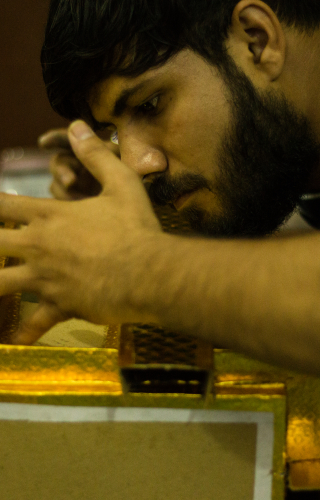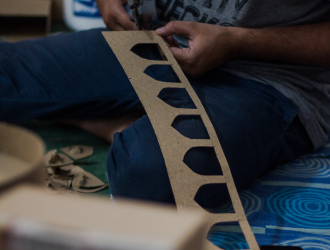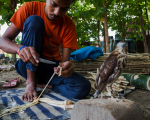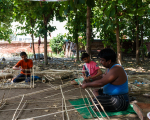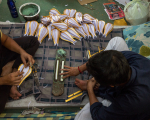Every year at the time of Muharram, people embrace the colour black which they associate with faith. Rituals and customs turn Muharram into a way of living. Majalis (a gathering of mourners with organised sermons/lectures on the tragedy of Karbala and Islam), processions, sabeel (a stall where tabarruk [food and water] is kept served for travellers, mourners, and visitors), maatam (gentle beating of the chest and head to mourn the tragedy of Karbala), taboot (coffin), and alam (flag) dominate everyday visuals and become Muharram’s identity. Yet, there is something that breaks the boundary of religion and ties Muharram to art; it is the practice of making and revering the taziya (homage to Imam Hussain but has also come to mean his mausoleum).
Muharram practices do not go without taziya making. A taziya, which is made in numerous forms and types is a mausoleum of Imam Hussain, the grandson of Prophet Muhammad (p.b.u.h), who was killed along with over 100 of his companions in the battle of Karbala in AD 680 against Yazid’s army, the then ruler of Syria. The word taziya comes from aza that translates to ‘commemorating the dead’; this practice marks respect for the martyrs of Karbala who were not buried after their killing. It is believed that Mongol ruler Taimur started the trend of taziya at the end of the fourteenth century. Taimur used a mud replica of Imam Hussain’s mausoleum, which was given to him in Karbala, and asked his men to offer their condolences to it in memory of Imam Hussain (a.s.). The practice soon became popular and people began making replicas of the mausoleum with varying crafts and skills to observe Muharram.
Generally, taziye (plural for taziya) are brought home on the evening of the first day of Muharram and are buried on the tenth day which is widely known as Ashoora, the day on which Imam Hussain was martyred. During Muharram, a separate space called azakhana (a private, temporary imambada, which are buildings where mourning rituals of matam and majalis take place during Muharram) is created where women perform the daily practices of Muharram, while men practice outside in processions and in imambade (plural of imambada).
Taziya has greater significance in women’s observance of Muharram because they are the keepers of the azakhana. Their connection to the taziya is much longer and tangible as they bring and cultivate azadari (mourning rituals and cultural depiction of the tragedy of Karbala) in homes. Women participate in the creation of the taziya which is used by themselves and the community; the domestication of taziya making enables women to practice the art in highly individualised ways. The most common and intricately decorated taziye are carboard taziye and bamboo taziye. The process of making both cardboard and bamboo taziya is complex, and various unorthodox techniques from tools and materials like home-made adhesives to upcycled cardboard are used. While taziya making is often seen as an economic activity, it is still driven by spirituality. A senior taziya artist from Kashmiri Mohalla, Lucknow Jani Mirza claims that ‘once a buyer claims possession of a taziya and takes it home it becomes divine.’[1] The making of taziya itself starts months before Muharram, in some places as early as six months before the observance.
A cardboard taziya is usually home-made and sold in shops, homes, and organised markets. Cardboard taziye are made out of cardboard and decorated with coloured paper, sequins, and adhesives. The cardboard is marked out using an unmetered scale, scissors, and a pointed metal device like a small pen. In most cardboard taziye, there is a chhatri(canopy).
A bamboo taziya is normally built in an open space because of its large size. Bamboos are adorned with plain and decorated paper or abrak (mica flakes) and sequins, threads, and adhesives of different kinds (flour, pulp of wood apple, Fevicol) are also used for decoration. In some places, pattha (vein from the back of the neck of a buffalo) is used in place of threads. The only tool used is a small machete to slice the bamboo into sticks.
Apart from cardboard and bamboo, taziye are also made out of mud, wood, metals, and grass of different kinds. The key architectural elements of a taziya are takhat (base) and dar (main edifice). To make a taziya, dars are placed on dars in a pyramidal shape above the takhat, and a gumbad (dome), made variously by various designers, is placed at the top. Each of the elements are individually made and then assembled to form the taziya.
This photoessay aims to present the complex process of taziya making which takes almost a year to complete and the establishment of its relationship with Muharram. The taziya making process can be divided into three categories: making, domestication, and burial. The part of the photoessay focussed on taziya making showcases various intricacies including the detailed measurement, drawing on the skeletal structure that becomes taziya, seamless cutting and gluing, and mastery of colour, texture, and embossing. The section on domestication of the taziya traces its journey from an economic commodity to an item of holy significance. Finally, the essay concludes with the burial of the taziya as it travels from homes and imambade to the karbalas (burial grounds) where it is buried and attains its ultimate holy status.
[1] Jani Mirza, in conversation with the author, January 20, 2020.
